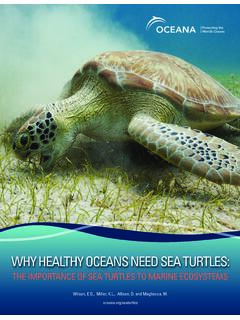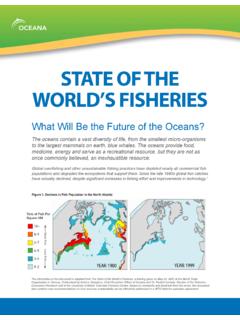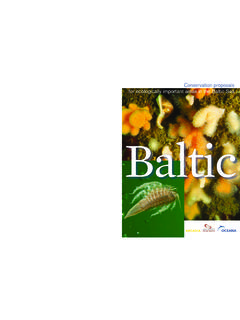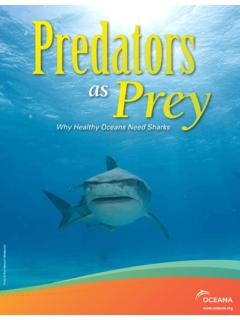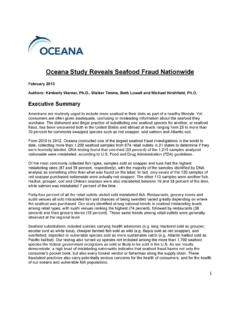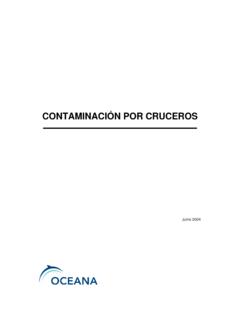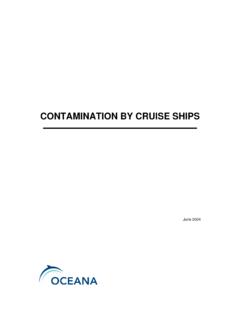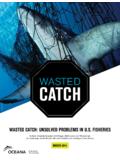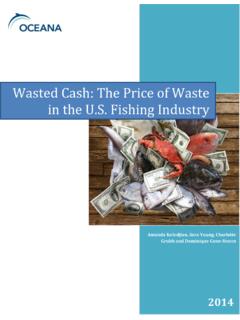Transcription of Impacts of Bottom Trawling - Oceana
1 Impacts of Bottom Trawling on Fisheries, Tourism, and the Marine Environment Margot L. Stiles, Julie Stockbridge, Michelle Lande, Michael F. Hirshfield May 2010. Belize Bottom trawl. Impacts of Bottom Trawling Bottom trawl nets are used to catch doors that can weigh more than shrimp and fish living on the several hundred pounds are used to seafloor from shallow coastal waters hold open the net, which can be as to extreme depths of 6,000 feet (2km) large as 40 feet tall and 200 feet wide (Morgan & Chuenpagdee 2003). In (Morgan & Chuenpagdee 2003, Stiles addition to the shrimp, many other et al. 2007). In some regions, animals are captured and later additional weights and hard rubber discarded, including undersized fish wheels are added to the front of the (Kelleher 2005, Clucas 1997).
2 Shrimp net. Trawling is one of the most indiscriminate kinds of fishing When the weighted nets and trawl because the small mesh used to doors are dragged along the retain the shrimp allows few other seafloor, everything in their path is animals to escape (Kelleher 2005). disturbed or destroyed, including seagrasses, coral reefs or rock Bottom Trawling uses heavily gardens where fish hide from weighted nets that are dragged predators (Roberts et al. 2005). across the ocean floor. Metal Untrawled corals Trawled rubble 1 Fish dumped by trawlers in Belize attract pelicans. Fish Thrown Away Bottom Trawling is one of the most In the Gulf of Mexico, scientists destructive ways to catch fish, and is estimate that for every pound of responsible for up to half of all shrimp caught, between four and ten discarded fish and marine life pounds of marine resources are worldwide (Kelleher 2005).
3 Valuable thrown away (Harrington et al. 2005, fish, turtles, seabirds, marine Nance and Scott-Denton 1997, mammals and other animals are all Alverson et al. 1994). Shrimp captured and discarded by Bottom Trawling in the Caribbean and trawls, and many do not survive Central America also has high (Morgan & Chuenpagdee 2003). In a discard rates, with shrimp trawls in side-by-side comparison, Bottom Panama discarding more than 80%. Trawling for spot prawns threw away of their catch (Teutscher 1999 in nine times as much bycatch as more Kelleher 2005). Even small-scale selective fishing gear (Reilly et al. fisheries catch high percentages of 2002). unwanted fish and marine resources when using Bottom trawls, including Brazil as well as Trinidad and Tobago (Kelleher 2005).
4 In 2007, shrimp trawlers in Belize landed only 19 metric tons of shrimp (FAO). and likely discarded about 76 to 190. metric tons of other marine life. The fish thrown away by Bottom trawlers in Belize are probably a third of total spiny lobster landings for the same year. Unwanted fish caught in Bottom trawl. R. Visser, Greenpeace 2. Fly fishing in the cayes. M. Paz, Green Reef, Marine Photobank Impact on Fisheries Shrimp trawls compete directly with Bottom Trawling often leads to traditional cast nets, a less wasteful overfishing because the gear is not and more fuel-efficient gear which selective and discards a lot of dead catches higher quality shrimp fish. Overfishing by Bottom trawls is (Ramos et al.)
5 1997). a direct threat to local fishing communities and to tourism from Fish that are unwanted and sport fishing. discarded by the Bottom trawler are often juveniles of valuable species caught by other fishermen. Caribbean Bottom trawls commonly catch juvenile grouper and snapper (Clucas 1997) and Gulf of Mexico shrimp trawls catch significant numbers of red snapper, porgy, and mackerel (Harrington et al. 2005). In Belize, scientists working near Bottom trawlers see slicks of snappers and other dead fish in their wake (P. Lobel, symposium presentation). Young snapper discarded by trawler in Belize. P. Lobel 3 Lobster fisherman. J. Stockbridge Impact on Fisheries (continued). Local fishermen catch fewer fish for lobster and crab fishermen in the US.
6 The same effort when competing with Industrial trawlers operated by Bottom trawls (Whitmarsh 2003, foreign fleets drag through the gear Ssentongo 1988). In Indonesia, local of local fishermen in Guinea, fishermen's catches declined 40% destroying wooden canoes, other after Bottom Trawling expanded gear, and causing personal injuries (JALA). Bottom trawls also conflict (Lowrey 2004, EJF 2007, JALA). with the operation of other kinds of fishing gear, leading to disputes with Dead fish discarded by a Bottom trawler. NOAA. 4. Spanish trawler fishing illegally at night. Oceana , Illegal fishing and the Deep Sea Inherently destructive fishing gear is Belize's deep sea resources remain especially dangerous when used for unknown and are likely to include illegal fishing, because a small similarly vulnerable species number of illegal fishermen can ( , ).
7 Many deep cause a lot more damage than they sea fish are exceptionally slow- would if using more selective gear. growing, late-maturing, and do not For this reason, banning destructive tolerate heavy fishing pressure gear is an important step against (Roberts et al. 2005 ). One of the illegal fishing, especially when quickest-ever boom-and-bust resources for enforcement are fisheries targeted a deep sea fish, the limited. Destructive gears are also orange roughy, which doesn't mature particularly risky in offshore waters, until 20 or 30 years old and lives for where law enforcement is more more than 125 years ((Froese & Pauly difficult and deep sea fish are more 2004, Koslow et al. 2000 ).)
8 Easily overexploited. 5 Spotted eagle , Impact on Tourism Ocean-based tourism involving willing to pay more for a dive trip snorkeling, diving, and sport fishing during which they are likely to see is one of Belize's most important marine wildlife; including economic activities, and is directly approximately $30 more to see a sea threatened by discards of the marine turtle, $35 to see a shark or $55 to see a wildlife people most want to see. healthy coral reef ( Oceana 2008). Bottom Trawling not only affects Several endangered and threatened valuable fish species, but also species in the US are in decline threatens sea turtles, sharks and rays, primarily because they are caught seagrasses and coral reefs (Morgan incidentally in destructive fishing gear, & Chuenpagdee 2003).
9 Tourists are including the smalltooth sawfish. Diver with horse-eye jacks. Oceana , H. Kaddachi 6. Sea turtle caught by destructive fishing gear. NOAA. Impact on Tourism (continued). Corals, seagrasses and other are also likely to be vulnerable to seafloor habitats are especially Bottom Trawling , though the Impacts vulnerable to disturbance by Bottom may not be as long-lasting as with Trawling , and can be extremely slow deep sea corals. Recent mapping of to recover (NRC 2002). Bottom southern Belize waters where Bottom Trawling flattens any upright structure Trawling takes place revealed a series on the seafloor (NRC 2002, Koslow et of small rock outcroppings, which al. 2000), destroying coral reefs and may provide refuges for groupers as other places where juvenile fish hide.
10 They move from the mangroves to the Hard- Bottom areas away from the reef reef ( , ). Untrawled Coral Trawled Coral Florida's Oculina Banks. , Dynamac / , NURC, UNCW. 7 Bans on Bottom Trawling Bottom Trawling has been banned in many different locations worldwide: Indonesia The government of Indonesia banned Bottom Trawling to increase catches and income for local fishermen and to end conflicts with industrial trawlers. (JALA). Florida, Georgia, North Carolina, and South Carolina (US). The South Atlantic Fishery Management Council banned Bottom Trawling in 23,000 square miles of rare deep-sea corals from North Carolina to Florida. This ban followed the destruction of more than 90% of a nearby bank of Oculina corals by Trawling .
